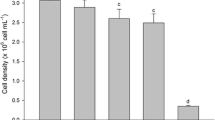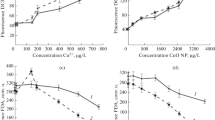Abstract
The mechanism of toxicity of ionic copper and copper complexes to growth, photosynthesis, respiration, ATP levels and mitochondrial electron-transport chain-activity in two marine diatoms, Nitzschia closterium (Ehrenberg) W. Smith (Hasle, 1964) and Asterionella glacialis Castracane, and one freshwater green alga, Chlorella pyrenoidosa Chick was investigated. Copper ions depressed both cell division and photosynthesis in A. glacialis and C. pyrenoidosa, whereas ionic copper concentrations which were inhibitory to cell division in N. closterium had no effect on photosynthesis, respiration, ATP production, electron transport or membrane ultrastructure. This suggests that in N. closterium, copper does not act on the chloroplast, the mitochondrion, or the cell membrane, since if it did, the above parameters should be affected. Copper-ethylxanthogenate was exceptional amongst the copper complexes in that it stimulated respiration, mitochondrial electrontransport and ATP formation in N. closterium under conditions of strongly inhibited cell division and slightly stimulated photosynthesis. Ionic copper toxicity may result from an intracellular reaction between copper and reduced glutathione (GSH), leading to a lowering of the GSH:GSSG ratio and suppression of mitosis. In addition, copper inhibits the enzyme catalase and reduces cell defence mechanisms against H2O2 and oxygen-free radicals. Lipid-soluble copper complexes are more toxic than ionic copper because both the metal and the ligand are introduced into the cell. Toxicity of ionic copper is ameliorated by trivalent metal ions in the growth medium, including those of Mn, Co, Al, Fe and Cr which form a layer of metal (III) hydroxide around the algal cell, adsorb copper and reduce its penetration into the cell. The degree of insolubility of the metal (III) hydroxide is related to its ability to protect against copper toxicity. In addition, manganese and cobalt catalytically scavenge damaging H2O2 and superoxide radicals, respectively, produced by the cell.
Similar content being viewed by others
Literature cited
Ahsanullah, M. and T. M. Florence: Toxicity of copper to the marine amphipod Allorchestes compressa in the presence of water-and lipid-soluble ligands. Mar. Biol. 84, 41–45 (1984)
Cedeno-Maldonado, A. and J. A. Swader: Studies on the mechanism of copper toxicity in Chlorella. Weed Sci. 22, 443–449 (1974)
Davies, A. G.: An assessment of the basis of mercury tolerance in Dunaliella tertiolecta. J. mar. biol. Ass. UK. 56, 39–57 (1976)
Erickson, S. J.: Toxicity of copper to Thalassiosira pseudonana in unenriched inshore seawater. J. Phycol. 8, 318–323 (1972)
Fisher, N. S. and G. J. Jones: Effects of copper and zinc on growth, morphology and metabolism of Asterionella japonica (Cleve). J. exp. mar. Biol. Ecol. 51, 37–56 (1981)
Florence, T. M.: Development of physico-chemical speciation procedures to investigate the toxicity of copper, lead, cadmium and zinc towards aquatic biota. Analytica chim. Acta 141, 73–94 (1982)
Florence, T. M.: The production of hydroxyl radical from hydrogen peroxide. J. inorg. Biochem. 22, 221–230 (1984)
Florence, T. M., B. G. Lumsden and J. J. Fardy: Evaluation of some physico-chemical techniques for the determination of the fraction of dissolved copper toxic to the marine diatom, Nitzschia closterium. Analytica chim. Acta 151, 281–295 (1983)
Florence, T. M., B. G. Lumsden and J. J. Fardy: Algae as indicators of copper speciation. In: Complexation of trace metals in natural waters, pp 411–418. Ed. by C. J. M. Kramer and J. C. Duinker. The Hague: Martinus Nijhoff/Dr. W. Junk Publishers 1984
Florence, T. M. and J. L. Stauber: Toxicity of copper complexes to the marine diatom Nitzschia closterium. Aquat. Toxic. 8, 11–26 (1986)
Florence, T. M., J. L. Stauber and K. J. Mann: The reaction of copper-2,9-dimethyl-1, 10-phenanthroline with hydrogen peroxide. J. inorg. Biochem. 24, 243–254 (1985)
Gavis, J.: Toxic binding of cupric ion by marine phytoplankton. J. mar. Res. 41, 53–63 (1983)
Guillard, R. R. L. and J. H. Ryther: Studies of marine planktonic diatoms. I. Cyclotella nana and Detonula confervaceae Hustedt (Cleve) Gran. Can. J. Microbiol. 8, 229–239 (1962)
Hare, T. A. and R. R. Schmidt: Synthesis of reduced glutathione from an endogenous source of sulfur immediately prior to nuclear division in synchronized Chlorella. Biochim. biophys. Acta 192, 537–539 (1969)
Hasle, G. R.: Nitzschia and Fragilariopsis species studied in the light and electron microscopes. I. Some marine species of the groups Nitzschiella and Lanceolatae, Skr. norske Vidensk-Akad. Mat.-naturv. K1 (N.S) 16, 1–48 (1964)
Holm-Hansen, O. and C. R. Booth: The measurement of adenosine triphosphate in the ocean and its ecological significance. Limnol. Oceanogr. 11, 510–519 (1966)
Kenner, R. A. and S. I. Ahmed: Measurements of electron transport activities in marine phytoplankton. Mar. Biol. 33, 119–127 (1975)
Kosower, N. S. and E. M. Kosower: The glutathione status of cells. Int. Rev. Cytol. 54, 109–160 (1978)
Lumsden, B. G. and T. M. Florence: A new algal assay procedure for the determination of the toxicity of copper species in sea water. Envir. Technol. Lett. (U.K.) 4, 271–276 (1983)
McBrien, D. C. H. and K. A. Hassall: The effect of toxic doses of copper upon respiration, photosynthesis and growth of Chlorella vulgaris. Physiologia Pl. 20, 113–117 (1967)
Magnuson, V. R., D. K. Harris, M. S. Sun, D. K. Taylor and G. E. Glass: Relationships of activities of metal-ligand species to aquatic toxicity. In: Chemical modelling in aqueous systems, pp 635–656. Ed. by E. A. Jenne. Washington D.C.: American Chemical Society 1979
Onfelt, A.: Spindle disturbances in mammalian cells. I. Changes in the quantity of free sulphydryl groups in relation to survival and c-mitosis in V79 chinese hamster cells after treatment with colcemid, diamide, carbaryl and methyl-mercury. Chem. biol. Interactions 46, 201–217 (1983)
Overnell, J.: The effect of heavy metals on photosynthesis and loss of cell potassium in two species of marine algae, dunaliella tertiolecta and Phaeodactylum tricornutum. Mar. Biol. 29, 99–103 (1975)
Ringbom, A.: Complexation in analytical chemistry, 395 pp. New York: Wiley Interscience 1963
Samuel, J. C.: The effects of copper on two species of unicellular marine algae, 125 pp. MSc. Thesis, University of Sydney 1976
Silio, F. and M. D. Angulo: Reversion of colchicine induced c-mitosis by indolylacetic acid-coenzyme A. In: Mechanism of mutation and inducing factors, pp 423–426. Ed. by Z. Landa. Prague: Academia 1967
Stauber, J. L. and T. M. Florence: The influence of iron on copper toxicity to the marine diatom, Nitzschia closterium (Ehrenberg) W. Smith. Aquat. Toxic. 6, 297–305 (1985a)
Stauber, J. L. and T. M. Florence: Interactions of copper and manganese: a mechanism by which manganese alleviates copper toxicity to the marine diatom, Nitzschia closterium (Ehrenberg) W. Smith. Aquat. Toxic. 7, 241–254 (1985b)
Stauber, J. L. and T. M. Florence: Reversibility of copper-thiol binding in Nitzschia closterium and Chlorella pyrenoidosa. Aquat. Toxic. 8, 223–229 (1986)
Steeman Nielsen, E. and L. Kamp-Nielsen: Influence of deleterious concentrations of copper on the growth of Chlorella pyrenoidosa. Physiologia Pl. 23, 828–840 (1970)
Steemann Nielsen, E., L. Kamp-Nielsen and S. Wium-Andersen: Influence of deleterious concentrations of copper on the photosynthesis of Chlorella pyrenoidosa. Physiologia Pl. 22, 1121–1133 (1969)
Stein, J. R.: Handbook of phycological methods. Culture methods and growth measurements. 448 pp. Cambridge: University Press 1973
Sunda, W. G. and S. A. Huntsman: Effect of competitive interactions between manganese and copper on cellular manganese and growth in estuarine and oceanic species of the diatom Thalassiosira. Limnol. Oceanogr. 28, 924–934 (1983)
Viarengo, A., M. Pertica, G. Mancinell, R. Capell and M. Orunesu: Effects of copper on the uptake of amino acids, on protein synthesis and on ATP content in different tissues of Mytilus galloprovincialis. Mar. envirl Res. 4, 145–152 (1981)
Author information
Authors and Affiliations
Additional information
Communicated by G.F. Humphrey, Sydney
Rights and permissions
About this article
Cite this article
Stauber, J.L., Florence, T.M. Mechanism of toxicity of ionic copper and copper complexes to algae. Mar. Biol. 94, 511–519 (1987). https://doi.org/10.1007/BF00431397
Accepted:
Issue Date:
DOI: https://doi.org/10.1007/BF00431397




